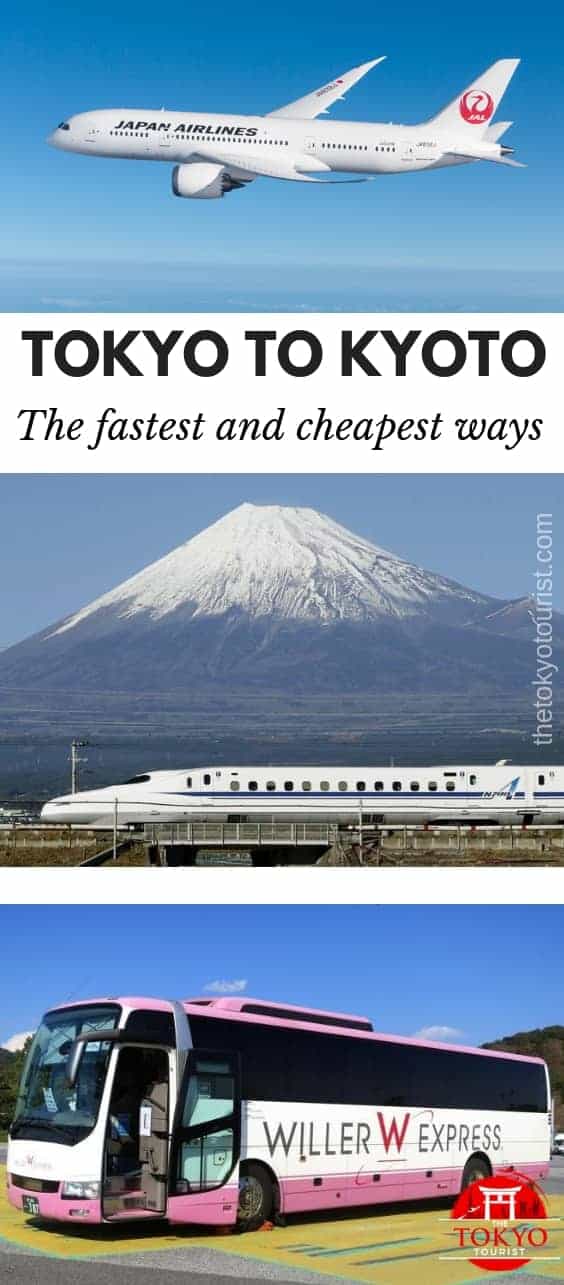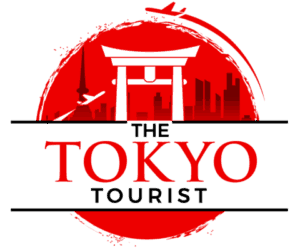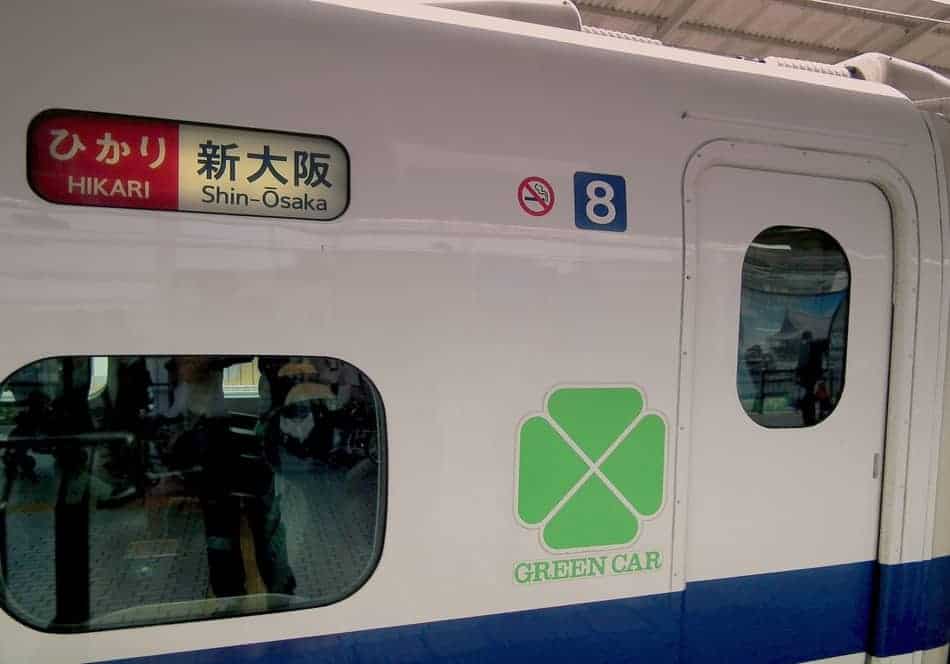Deprecated: mb_convert_encoding(): Handling HTML entities via mbstring is deprecated; use htmlspecialchars, htmlentities, or mb_encode_numericentity/mb_decode_numericentity instead in /home2/thetoky7/public_html/wp-content/themes/acabado/functions.php on line 2119
-
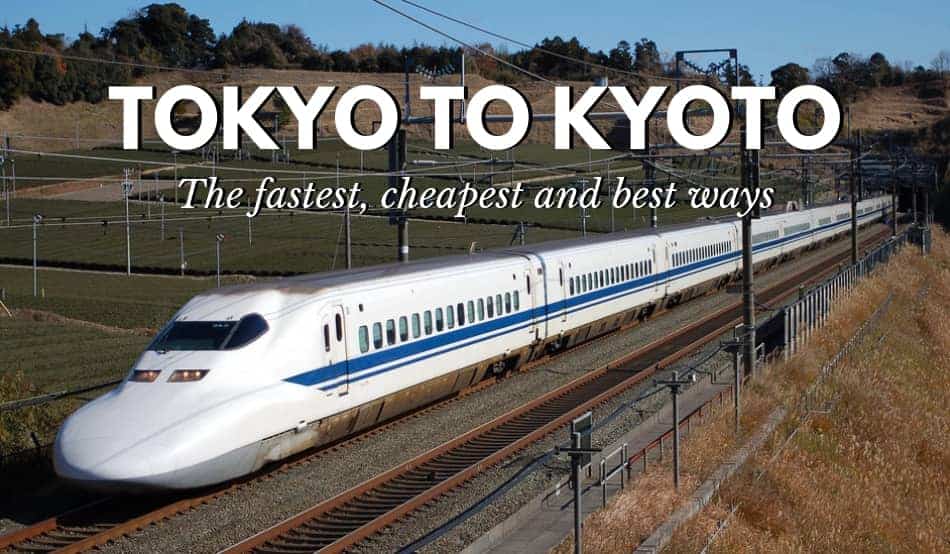
Is Shinkansen the best way of getting from Tokyo to Kyoto?
Updated: July 2019
You’re here because you want to know how to get from Tokyo to Kyoto, right? You want to find the best way for you. In this mini-guide I’ll run you through the following ways:
- The fastest way
- The cheapest way
- The way of the explorer
- And the best way
In a hurry? Want to skip all the details? Jump to the summary 
Before we get into the nitty-gritty let me just start off with saying (spoiler alert!): If you’re getting a JR Pass, it’s already settled. You’d be stupid not to use it. Not sure if a Japan Rail Pass is worth it? Check out my Japan Rail Pass guide.
If you’re not planning to get a JR Pass, read on but know that although I cover various ways of getting from Tokyo to Kyoto, I’ll mainly focus on Shinkansen. It’s the most popular way, and in my opinion, the best way.
Bullet train: Shinkansen from Tokyo to Kyoto
With an operating speed of 185 mph (300 km/h), it’s one of the world’s fastest trains. The Tokaido Shinkansen Line (Tokyo – Kyoto – Osaka) alone has transported more than 5 billion passengers since it saw the light of day back in 1964. Japan’s excellent high-speed railway network is world famous for its speed, punctuality and safety record.
Key Facts for the Shinkansen Network
- 10 billion passengers (since 1964)
- 424,000 daily passengers
- 342 daily departures
- 0 fatalities due to derailments or collision (since 1964)
- An average of 0.9 minutes delay per train (including delays due to uncontrollable causes, such as natural disasters)
The Perfect Way to Travel from Tokyo to Kyoto?
Not so fast! It is no doubt fast, safe and efficient but (there’s always a but!) it’s also quite expensive. In fact, it’s easy to find flights that are cheaper. So how costly is it?
Time and Money
The price ranges from ¥10,300 with the cheapest train in the off-season to ¥18,690 with the fastest train with 1st class reservation in the peak season. The time it takes from Tokyo to Kyoto ranges from 218 minutes with the slowest train to 135 minutes with the fastest train.
This might be a bit confusing, but on Japan Railway you pay for the fare + seating fee (except for a special deal with the Kodama train). The fare is a fixed price, but the seating fee is based on the type of seat you chose. In all, there are three criteria for pricing.
- Type of train/speed
- Nozomi, Hikari or Kodama
- Seating fee
- Unreserved seat, reserved seat, green seat
- Peak, normal or off-season
- Peak
- December 25 – January 10
- March 21 – April 5
- April 28 – May 5
- July 21 – August 31
- Off-season
- Januar 15 – February 28 *
- June 1 – June 30 *
- September 1 – September 30 *
- November 1 – December 20 *
- Normal
- You do the math!
- Peak
* Except for weekends and national holidays.
Ticket prices
Take a look at this table to plan your trip with Shinkansen from Kyoto to Tokyo. Remember, you have to pay for both the fare and a seating fee (even if the train is full and you don’t get to sit.) Just keep in mind that you’ll save money with a JR Pass if you’re planning to use Shinkansen more than once in a span of 7 days. The pass also comes with free seat reservation.
UPDATED: September 2018
If you’re on mobile you might have to scroll to see all the columns (there are three trains listed).
[table id=5 responsive=scroll /]
Infants and babies (0 to 5 years) travel for free. Children from 6 to 11 years get 50% off. 12 years and older counts as adults.
The Different Seats
Unreserved seats are pretty much self-explanatory. This means you don’t have a reserved seat and thus you run the risk of having to stand. You just need to get on a car for unreserved seats (indicated by signs by the doors and on the platforms) and just hope you get lucky.
How likely is it that you have to stand for your trip? During peak season and national holidays, it’s usually pretty crowded. During the off-season, you’ll probably be fine, but there’s a risk you won’t be able to find a free seat. You can always get a seat later on your journey when people leave the train. Also, if you’re traveling in a group, it can be difficult to get unreserved seats in a group. So do you want to gamble or pay the extra yen?
Reserved seats are… You’ve guessed it! Reserved! For a fee of ¥400-¥1,000, you can reserve your seat. No scrambling for the unreserved seats and you and your group can sit together. When you reserve your seats at a Midori no Madoguchi (ticket office), you’ll be able to choose which seats you want. If you’re a group of more than four, you can reserve two 3-seaters and rotate one of them. (You can rotate all the seats!) That way your group of up to six people can sit together.
Green seats are larger and come with a footrest. There is more room between the seats, and you can recline your seat 40°. But in my opinion, it’s not worth it. I’ve tried green seats a couple of times, but the difference in comfort wasn’t big enough for it to be worth it. At least not for me. All the seats on Shinkansen trains are good and more spacious than for example the standard seats on airplanes.
But if you do decide to splurge, how do you find your car? No worries, the leaf clover got you. This is just an example of how a cart with green seats can be marked.
Different Trains, Different Speeds
There are three types of trains running on the Tokaido Shinkansen Line. They all have the same kind of seating arrangement (unreserved, reserved and green seats) but they have different speeds. You can see the time it takes from Tokyo to Kyoto in parentheses.
- Nozomi (135 – 138 minutes. About 2 hours and 20 minutes)
- Hikari (158 – 162 minutes. About 2 hours and 40 minutes)
- Kodama (218 minutes. About 3 hours and 40 minutes)
Nozomi is the newest and fastest train. It’s a super-express train and stops at fewer stations than both Hikari and Kodama. The Nozomi leaves from Tokyo to Kyoto an impressive four to seven times per hour.
IMPORTANT: Unlike Hikari and Kodama, rides on Nozomi is not covered by Japan Rail Pass.
Hikari stops at a few more stations than Nozomi and thus takes about 20 minutes longer to make its way from Tokyo to Kyoto. Some of the Hikari trains are the same model as the Nozomi trains (N700), but they also use an older type of train. You’ll especially notice this in the cars with green seats. There you’ll see the seats are more rugged and a bit less comfortable.
Hikari leaves from Tokyo to Kyoto two times per hour.
Kodama stops at every station and is the slowest train out of the three. But it’s an interesting option as it’s the cheapest one. But to get the cheaper tickets you have to jump through some hoops. Skip down to How to Make it Cheaper? To learn all about it. LINK
General Info
Here are a few things you should know about Shinkansen. Get your notepad out!
When Does Shinkansen Run? Is it a 24/7 Service?
Shinkansen runs from about 6 a.m. to midnight. From 12 a.m. to 6 a.m. the tracks are closed down due to maintenance. The last departure from Tokyo to Kyoto is around 9 p.m.
Baggage On Shinkansen
- Maximum two pieces of baggage per person
- Maximum 66 lbs (30 kg) per bag
- Height+depth+width must be under 98” (250 cm)
There are storage racks above the seats where you can store hand luggage (it’s bigger than the overhead compartment in airplanes). For bigger pieces of luggage, it can be somewhat difficult to store it properly. Shinkansen hasn’t got much space assigned for storing bags.
- You can store it in the space behind the last row of seats in each cart.
- If you’re in a cart with reserved seats, you can often find empty seats where you can place your bag
- If you have a small to a medium bag, you can store it in between the seat in front of you and your legs.
On weekdays there’s usually more room for baggage as most people use Shinkansen to travel to work and don’t have bags with them. But is it safe to leave your bags unattended? You should never be naive, and I will certainly not give you any guarantees, but I don’t even think twice about doing it. There’s very little crime in Japan, and I bet theft on Shinkansen is even lower, as you need a ticket to ride.
If you don’t want to worry about your baggage, you can check out baggage delivery services. It’s very reliable and reasonably priced.
Pro Tip
If you’re traveling from Tokyo to Kyoto and want an unobstructed view of Mount Fuji, be sure to reserve a seat on the right side of the train.
I bet you’ve already figured this out, but if you’re going from Kyoto to Tokyo and want to see Mount Fuji, you need to get a seat on the left side of the train
Food on Shinkansen
The staff will bring food carts to your seats, but the selection is limited. Although they do serve beer!
You’re allowed to bring your own food and drink. Many decide to buy a bento box at the station and just buy cold beverages on the train. By the way, a bento box sold at a train station is called an ekiben. “Eki” is the Japanese word for train station and “ben” is short for bento. And so you have ekiben.
At a convenience store, a bento box costs ¥300-¥600. At a train station, it’s twice and even sometimes three times that price.
-
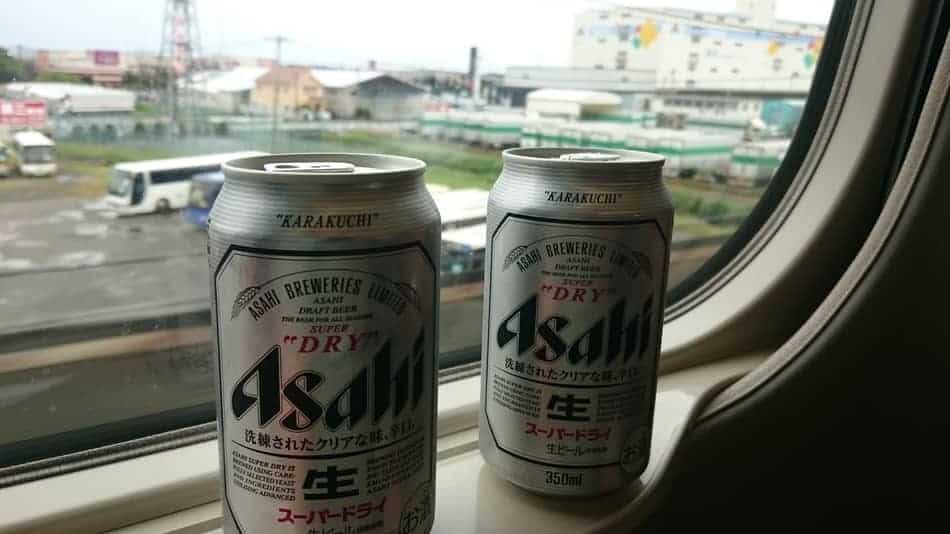
I’ve made it a tradition to have a beer or two when I ride Shinkansen. © The Tokyo Tourist
Cleanness
Shinkansen is clean and well-oiled machinery. When the train reaches the end station, the cleaning crew pours into the carts and swipes the floor, checks the luggage racks and wipes every tray. Only one crew member per cart with 100 seats. They must complete the task in under 7 minutes. Check out this video to see how it’s done.
How to Travel Cheaper With Shinkansen?
The cheapest Shinkansen option from Tokyo to Kyoto is to purchase a Platt Kodama Economy Plan from JR Tokai Tours. Kodama is slower than Nozomi and Hikari because it stops at every station, but I would say it’s still an excellent way to travel. After all, it’s the iconic Shinkansen!
Depending on whether you travel in peak or off-season the tickets are ¥10,300 to ¥11,600. It includes:
- Fare and seating fee from Tokyo to Kyoto
- You can reserve a seat on any Kodama train
- A 12 oz (350 ml) soft drink or beer
Ticket Information:
- There are only a limited number of special price seats available
- You need to purchase the tickets by the day before use
- Your ticket is only valid for a specific train (if you book a 1 p.m. train, you can’t take a later train if you miss
- You can not change your reservation after you reserved
- You have to buy your ticket at a JR Tokai Tours office
Check out JR Tokai Tours’ website for more information. And use HyperDia.Com to plan your trips.
Tokyo to Kyoto with Shinkansen
Time: 3 hours and 40 minutes
Money: ¥10,300 to ¥11,600
Domestic Flights
I said you could get flights that were cheaper than the Shinkansen tickets. I stand by that! But what I didn’t mention was you can’t actually fly to Kyoto. Why, you ask? Because of landing difficulties. There is no airport in Kyoto! The closest airport to Kyoto is Kansai International Airport in Osaka. The distance between the two cities is 35 miles (56 km).
From there you’ll need to find transport to Kyoto by bus, train or taxi. You can grab an Itami-Airport Limousine Bus from Kansai to Kyoto for ¥1,310 yen. It takes about 30 minutes.
Airplane vs. Shinkansen. What is Faster?
The fastest Shinkansen (Nozomi) takes 2 hours and 20 minutes. The fastest flight takes 1 hour and 5 minutes. So that’s that? The airplane wins? No, it’s not that easy. First of all, before you get on the one hour flight, you need to make your way to Haneda (or Narita) and then go through the security checks. And do not forget, when you land, you’re not even in Kyoto. You are in Osaka. So first you need to collect your bag and then jump on the train/bus to Kyoto.
When you take this into account, you’re looking at 3.5-4 hours of travel time. That’s about the same time as the slowest Shinkansen (Kodama).
Cheap Domestic Airlines
The low-cost airlines can be surprisingly affordable. Here are some of the usual suspects.
- All Nippon Airways (ANA)
- Japan Airlines
- Jetstar Japan
- Peach
- Starflyer
What they have to offer in terms of baggage limitations vary, so be sure to read the fine print before you book your flight.
How Much Does it Cost?
As you all know, the prices are determined by several different factors. Which day of the week, what time of the year, what time of the day and how far in advance you book. Just to give you an idea I looked up all the prices in October 2018, which is one month from now.
Here are the results:
- Most expensive: ¥9,007. Saturday, October 20 (All Nippon Airways)
- Cheapest: ¥4,821. Tuesday, October 30 (Jetstar)
- Avg. lowest price October: ¥6,900
We see a range from ¥4,800 to ¥9,000, with an average of ¥6,900. That’s pretty cheap and indeed cheaper than Shinkansen. But just like with the travel time, you do have to include transport to Haneda Airport and transport from Osaka to Kyoto.
If you book a cheap flight and use inexpensive transport to and from the airports, the flight option is cheaper than Shinkansen. You can get to Kyoto for as little as ¥7,000 whereas the cheapest Shinkansen ticket is ¥10,300.
Tokyo to Kyoto with a budget airline
Time: 3.5 to 4 hours
Money: ¥4,800 to ¥9,000
Bus from Tokyo to Kyoto
You have a few well-renowned bus companies to choose from. Kosokubus are good for night buses. It will take you about 7 hours and cost you from ¥3,000 to ¥5,000. Book 1-2 weeks in advance and you’ll get the cheap tickets. You can bring carry-on luggage and you can store one piece of bigger luggage in the trunk of the bus
Some people have problems sleeping on buses. If you’re one of them, keep in mind that you’ll arrive in Kyoto 5 a.m. – 8 a.m. If you can’t check into your hotel until 3 p.m., you’ll probably be a walking zombie.
Don’t want to ride the night bus? Then Willer Express is a sound choice. They’re a reputable bus company with many popular routes. You can also use them from Tokyo to Mount Fuji.
Prices start at ¥4,000, and the ride will take about 9 hours. A bit longer than the night bus because of the traffic.
Tokyo to Kyoto by bus
Time: 7 to 9 hours
Money: ¥3,000 to ¥6,000
Seishun 18 Ticket
Are you a real explorer on a tight budget? Well, then this is the choice for you! Seishun 18 is a special discount ticket that allows five days (not necessarily continuous) of unlimited travel in the Japan Railways system (not including Shinkansen and limited express trains) but only during specific times of the year.
When Tickets Must Be Purchased and Used
- Buy: February 20 to March 31
- Use March 1 April 10
- Buy: July 1 to August 31
- Use: July 20 to September 10
- Buy: December 1 to December 31
- Use: December 10 to January 10
The same ticket can be used for several people. If you’re traveling with a partner and you both, for example, want to go back and forth to Kyoto from Tokyo (with a stayover), you’ll use four of the five days. If you’re traveling alone, this ticket will last for five full days. Just be sure to use all of the five days within the specified period. More details on the official site.
Japans Cheapest Travel Option
The price of the Seishun 18 ticket is ¥11,850. For five days of unlimited travel by local and rapid JR trains that’s an incredible deal. You can’t beat ¥2,370 per day.
Complex and Time-Consuming
Here you’ll really need HyperDia.com to help you figure out the best route. And even with that help, you’ll still need to navigate all the different train stations.
Just to give you an example of how time-consuming this can be. If you’re only traveling by local and JR trains from Tokyo to Kyoto, it will take you 8 to 9 hours, and you’ll need transfer at least 5 times. It will take time, but it’s the perfect budget pick for the explorer type.
Tokyo to Kyoto by local and JR trains
Time: 8 to 9 hours
Money: ¥2,370 (¥11,850)
TL;DR
Four different means of transport from Tokyo to Kyoto if you don’t have Japan Rail Pass.
- The fastest way
- Shinkansen with Nozomi
- Time: 2 hours and 20 minutes
- Cost: ¥13,080 (unreserved seat)
- Shinkansen with Nozomi
- The cheapest way
- Seishun 18 Ticket (local and JR trains)
- Time: 8 to 9 hours
- Cost: ¥2,370
- Seishun 18 Ticket (local and JR trains)
- The best way (in my opinion!)
- Shinkansen with Platt Kodama Economy Plan.
- Time: 3 hours 40 minutes
- Cost: ¥10,300 to ¥11,600
- Shinkansen with Platt Kodama Economy Plan.
- A viable option, but you should spend at least one day in Osaka
- Low-cost airline
- Time: 3.5 to 4 hours
- Cost: ¥4,800 to ¥9,000
- Low-cost airline
Did I miss something? Please let me know in the comments down below!
